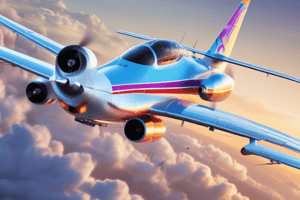Podcast
Questions and Answers
Which parts of the airplane are flight controls typically associated with?
Which parts of the airplane are flight controls typically associated with?
- The fuselage and the cockpit
- The wing and the vertical and horizontal stabilizers (correct)
- The tail and the nose
- The engine and the landing gear
What is the purpose of flight controls?
What is the purpose of flight controls?
- To maneuver the airplane and control it from takeoff to landing (correct)
- To allow the pilot to sleep during the flight
- To increase the weight of the airplane
- To provide entertainment for the passengers
How do flight controls function?
How do flight controls function?
- By changing the shape or aerodynamic characteristics of the surface they are attached to (correct)
- By playing music for the passengers
- By adjusting the temperature inside the cockpit
- By changing the color of the airplane
Which flight control is responsible for longitudinal control around the lateral axis?
Which flight control is responsible for longitudinal control around the lateral axis?
What is the name of the flight control on a v-tail configured airplane that handles longitudinal control?
What is the name of the flight control on a v-tail configured airplane that handles longitudinal control?
What is the movement around the lateral axis called?
What is the movement around the lateral axis called?
Which flight control is commonly used to move the airplane around the lateral axis?
Which flight control is commonly used to move the airplane around the lateral axis?
What are the possible flight controls used to move the airplane around the lateral axis?
What are the possible flight controls used to move the airplane around the lateral axis?
Which control input causes the nose of the airplane to pitch up or pitch down?
Which control input causes the nose of the airplane to pitch up or pitch down?
What is the effect of pulling back on the control wheel?
What is the effect of pulling back on the control wheel?
Which axis does the airplane rotate around when the elevator is moved?
Which axis does the airplane rotate around when the elevator is moved?
Which flight control is responsible for lateral control around the longitudinal axis?
Which flight control is responsible for lateral control around the longitudinal axis?
Which axis of an airplane is controlled by the rudder?
Which axis of an airplane is controlled by the rudder?
Which control input causes the nose of the airplane to pitch up or pitch down?
Which control input causes the nose of the airplane to pitch up or pitch down?
Which flight control is responsible for yaw control?
Which flight control is responsible for yaw control?
What happens when the right rudder pedal is pushed?
What happens when the right rudder pedal is pushed?
What controls the movement of the rudder?
What controls the movement of the rudder?
What is the purpose of using the rudder during a turn?
What is the purpose of using the rudder during a turn?
When is pressure on the rudder no longer needed during a turn?
When is pressure on the rudder no longer needed during a turn?
What is the purpose of a trim tab on a flight control?
What is the purpose of a trim tab on a flight control?
Where are trim tabs typically installed on an airplane?
Where are trim tabs typically installed on an airplane?
What is installed on the trailing edge of the stabilator to reduce sensitivity to pilot input?
What is installed on the trailing edge of the stabilator to reduce sensitivity to pilot input?
What are the three types of tabs mentioned in the text?
What are the three types of tabs mentioned in the text?
Why would a wing designed for maximum lift at low airspeed not be suitable for higher speed flight?
Why would a wing designed for maximum lift at low airspeed not be suitable for higher speed flight?
What are some examples of retractable high lift devices?
What are some examples of retractable high lift devices?
What are the four different types of flaps mentioned in the text?
What are the four different types of flaps mentioned in the text?
What is the purpose of wing flaps?
What is the purpose of wing flaps?
Where are leading edge flaps typically installed?
Where are leading edge flaps typically installed?
What is the purpose of deploying plain flaps downward on the wing?
What is the purpose of deploying plain flaps downward on the wing?
Explain the difference between a slotted flap and a plain flap, and how their deployment affects the airflow over the wing.
Explain the difference between a slotted flap and a plain flap, and how their deployment affects the airflow over the wing.
Describe the characteristics and advantages of a Fowler flap compared to other types of flaps.
Describe the characteristics and advantages of a Fowler flap compared to other types of flaps.
What are leading edge slots and how do they contribute to the aerodynamics of a wing?
What are leading edge slots and how do they contribute to the aerodynamics of a wing?
What is the difference between leading edge slats and slots?
What is the difference between leading edge slats and slots?
How do leading edge slats deploy on most commercial airliners?
How do leading edge slats deploy on most commercial airliners?
What causes the automatic deployment of leading edge slats on some airplanes?
What causes the automatic deployment of leading edge slats on some airplanes?
Flashcards are hidden until you start studying




